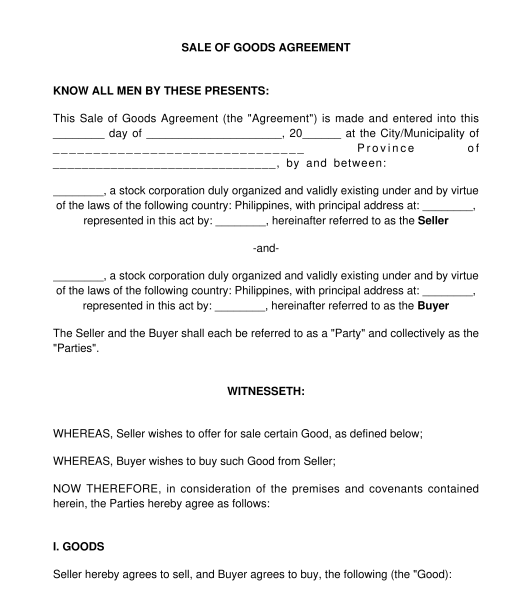 09/18/2025
09/18/2025

Answer a few questions and your document is created automatically.

Your document is ready! You will receive it in Word and PDF formats. You will be able to modify it.

 09/18/2025
09/18/2025
 Word and PDF
Word and PDF
 4 to 6 pages
4 to 6 pages
A Sale of Goods Agreement is a contract that a seller and a buyer can enter into for the sale of certain goods. It outlines the terms and conditions of the sale, such as the price and delivery information. This document can be used regardless of whether the good or goods being sold are brand new or second-hand. It likewise covers any type of sale, whether it's a one-time sale or multiple shipments overtime.
In a Sale of Goods Agreement, the ownership of the goods transfers to the buyer.
This document can be used as one of the following types of contracts for the sale of a motor vehicle:
While a Sale of Goods Agreement and a Distribution Agreement are similar in that they transfer the ownership of goods or products from the seller to the buyer, in a Distribution Agreement, the distributor markets, sells, or distributes the products of the supplier, while in a Sale of Goods Agreement, the buyer is not under any obligation to distribute the products or goods that were bought from the seller.
The buyer and the seller are the parties who should sign the Sale of Goods Agreement. Note that the seller must be the owner of the goods. If the buyer or the seller is an organization, the signatory may be the organization's representative.
The organization's representative must be equipped with a Secretary's Certificate, if the buyer or the seller is a corporation, a Partners' Certificate if the buyer or the seller is a partnership, or a Special Power of Attorney if the buyer or the seller is a sole proprietorship or individual, before they sign the Sale of Goods Agreement.
Note that minors or persons below 18 years of age cannot by themselves buy or sell goods under a Sale of Goods Agreement. Their parents or legal guardians should sign the agreement for them in their exercise of parental authority over the said minor.
Once the Sale of Goods Agreement is ready, at least two original copies of the same must be printed, and the buyer and the seller should review and sign all original copies of the same.
The buyer and the seller may notarize the Sale of Goods Agreement by acknowledging the same before a notary public in which case at least three original copies should be printed. The notary public will require one original copy of the document. Once notarized, the seller and the buyer should each keep at least one original copy of the notarized document.
The following should be attached, if applicable:
No, however, notarization will make the existence of the agreement easier to prove in case a dispute concerning the same is brought to court. Further, notarization makes the agreement a public document, which forces other persons who are not parties to the agreement to respect the terms and conditions in the agreement.
This is recommended if there are many goods to be sold or if the price involved is high.
Notarization fees for a Sale of Goods Agreement are typically PHP100 to PHP500. However, some notaries public may charge based on the percentage of the amount of purchase price involved, which is usually ay 1%.
If the seller sells all of his goods under the Sale of Goods Agreement, the seller may be required to apply for a Certificate of Registration of Bulk Sales before the Department of Trade and Industry.
The purpose of this certificate is to avoid defrauding the creditors or other stakeholders of the seller. The seller should make a sworn statement laying down the list of creditors to whom the seller may be indebted including the amount of any existing loans that are not yet paid by the seller. The seller should also provide a detailed inventory of the goods before their ownership is transferred to the buyer, and notify the creditors listed in the sworn statement at least ten days before the actual sale of the products by the seller to the buyer.
The above requirements and other requirements (i.e. sole proprietorship, partners, or corporate board resolution) included in the following website of the Department of Trade and Industry should also be completed.
A Sale of Goods Agreement contains the following information:
The Civil Code of the Philippines governs sales of goods. Further, other laws, such as the Philippine Competition Act (Republic Act No. 10667), and the Bulk Sales Law may also apply.
You fill out a form. The document is created before your eyes as you respond to the questions.
At the end, you receive it in Word and PDF formats. You can modify it and reuse it.
Guides to help you
Sale of Goods Agreement - sample template
Country: Philippines